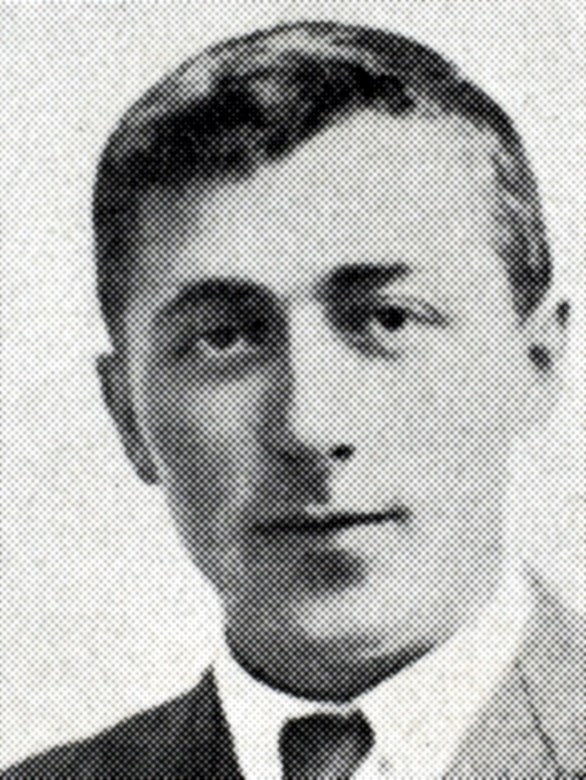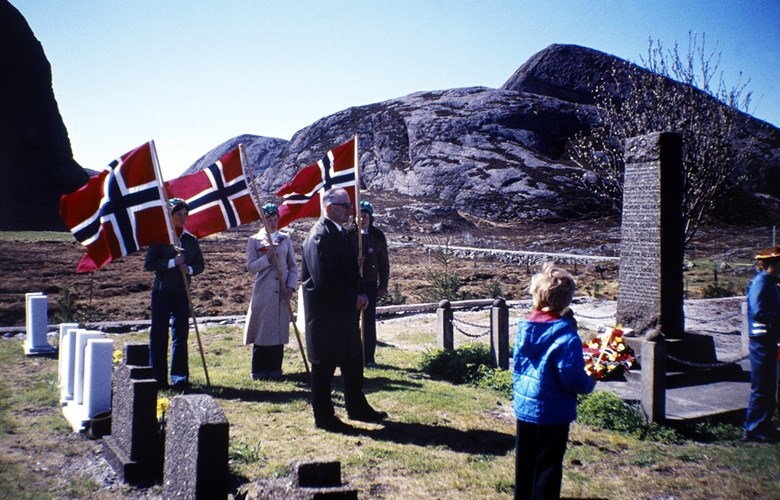Two memorial stones
Værlandet and Bulandet lost six men. Bernt Myrvåg fell in the battles for the liberation of the Netherlands at Walcheren. His brother Harald and Knut Landøy died in captivity in Germany. Trygve Verøyvik lost his life in the Norwegian Navy, and the brothers Asbjørn and Vemund Melvær went down in a plane crash.
On 20 May 1947, a memorial stone for the brothers Melvær was unveiled at their home at Melvær. The stone at Værlandet was unveiled in August of the same year, and stands in memory of all the fallen soldiers from Værlandet and Bulandet.
The stone and the inscription
The memorial stone stands on Bernt Myrvåg's grave. He was buried first at Walcheren, but was later moved home and buried in the churchyard at Værlandet. The memorial is two metres high and surrounded by stones linked by chains.
In addition to the names (with occupation, dates of birth and death, and where they lost their lives) are carved a Bible verse (above) and one stanza from the national hymn Landet vårt (our country) by Arne Garborg (below):
If these should hold their peace * the stones would immediately cry out* Luke, 19,40.
Her ligg dei, grav i grav (here they lie, grave on grave)
frå hei og ned til hav som (from the hills and down to sea which)
stridde so. Gud sign kvar (fought hard. God bless each)
ærleg svein som søv der under (honest boy who sleeps there under)
stein. Gud sign dei kvar (stone. God bless each every)
og ein der dei er no. (one where they are now)
Biographies in the book Våre falne (Our Fallen)
"LANDØY, KNUT ANDREASSON, fisherman, Askvoll. Born 11 March 1896 at Askvoll, son of the fisherman Andreas Landøy, born 1859, and Anne Cecilie née Vilnes, born 1868 same place. Engine course. Was arrested by the Germans on 17 July 1942 because he had not handed in his radio set. Did time in different prisons in Norway until he was taken to Germany on 15 February 1943. Came to Sachsenhausen, but was later taken to another camp for some time. Was taken back to Sachsenhausen, ill, and died on 29 April 1943."

"MELVÆR, ASBJØRN, fisherman and farmer, Askvoll. Born 17 May 1908 at Askvoll, son of the farmer and fisherman Magnus Melvær, born 1877, and Maria née Vilnes, born 1878, both at Askvoll. Married 1935 in Bergen to Hildur Johanne Knoff Strøm, born 1914. Three children.
Took part in the importation of arms from England and hiding them. Was arrested on 20 May 1942 and taken to the prison in Bergen, from there to Ulven and Grini. On 30 September 1943 taken to Natzweiler and died there on 3 November 1944.
Note: According to Rigmor Norheim, Asbjørn's daughter, Asbjørn survived Natzweiler, and that he was later taken to Dautmergen, a unit under Dachau."
"MELVÆR, VEMUND, fisherman, air gunman, Askvoll. Born 1 February 1922 at Askvoll, son of farmer and fisherman Magnus Melvær, born 1877 and Maria née Vilnes, born 1878, both at Askvoll. Secondary school. Went to England on 12 August 1941 and joined the Air Force. Took several courses and became a gunman in the Naval Air Force, 330 Squadron, on Shetland. On 4 October 1944, his airplane was on mission against German U-boats in the North Sea, but never returned. Awarded war medal post mortem. King Haakon VII's 70 year medal."
"MYRVÅG, HARALD, fisherman, Askvoll. Born 27 September 1914 at Askvoll, son of farmer and fisherman Teodor Myrvåg, born 1896, and Sofie née Nikøy, born 1888, both at Askvoll. Married 1937 to Kristine Kalvåg, born 1910, died 1938. One child. Hid arms smuggled in from England, handled special consignments, took part in the export organization at Bulandet. Arrested on 19 May 1942, taken to Bergen and Grini, and from there on 30 September 1943 to Nacht und Nebel camp in Germany. Died 13 May 1944 in Natzweiler. Brother Bernt fell 1945."

"MYRVÅG, BERNT, TEODORSEN, fisherman, Askvoll. Born 22 January 1921 at Askvoll, [..] Escaped from German forced labour unit and went to England in the summer of 1941. Became soldier and paratrooper, joined the unit called "the Green Devils". Took part in the invasion of Belgium and the Netherlands. Fell at Walcheren on 14 February 1945. Buried at Walcheren. Brother Harald died in Germany in 1944.
Note: Moved home and buried in the churchyard at Værlandet."

"VÆRØYVIK, TRYGVE, stoker, Askvoll. Born 2 January 1922 at Askvoll, son of Torvald T. Værøyvik, born 1896 same place, and Johanne née Helgheim, born at Jølster. Fisherman, but fled from Værlandet to England in August 1941 on a fishing vessel and joined the Norwegian Navy. Served on different vessels, among them the corvette "Tunsberg Castle". This vessel was blown up by a mine in north Norwegian waters on 12 December 1944, but Værøyvik survived. Was lost on 8 May 1945 when the minesweeper N.Y.M.S. 382 was sunk in the English Channel."
The unveiling ceremony
The memorial stone at Værlandet was unveiled on Saturday, 2 August 1947. "- It was a memorable day," the newspaper Firda wrote, "and a moving memorial ceremony which will be for ever remembered by those present. Early in the morning the boats began to arrive, and in the end there were several hundred."
Finn Fluge Pedersen, a prisoner friend of those who did not return, gave the unveiling speech. He described them as fine, reliable men, boys who yearned for freedom and justice, who had a firm belief that one day this would prevail, and that the flag would fly clean and free over the country.
Several wreaths were laid, from parents and children, brothers and sisters, relatives, friends, acquaintances, the Norwegian Navy, the municipality of Askvoll, friends of the prisoners in Germany, and the resistance movement in England.
The ceremony was concluded in the schoolhouse.
Kåre Seines - should have been included on the stone
Kåre Seines from Bodin came to Askvoll a short time before the war. He lived at Værlandet and supported himself as a farm hand and fisherman. He took part in helping refugees get across to England, and he himself had to escape to England in August 1941.

His name was not on the memorial stone for the fallen soldiers from Værlandet and Bulandet. That was a mistake, it was said afterwards. His name should have been included. But Kåre Seines is not forgotten completely. His name is included on the memorial stone at Askvoll church commemorating all fallen soldiers from Askvoll municipality.
"SEINES, KÅRE ANTONIUS, junior seaman, Askvoll. Born 25 September 1914 at Bodin, son of Karl Seines, born 1878, and Anna née Johansen, born 1879, both at Bodin. Was before the war a fisherman. Was active in refugee assistance, and had to escape to England in August 1941. Was lost 21 December of that year when the SS Annavore was torpedoed in the Atlantic, seven days' voyage out of Gibraltar."
Memorial poem on 9 April 1990
For the 50th anniversary of the German attack on Norway, on 9 April 1990, Sverre J. Landøy wrote a memorial poem called Minnesteinane (the memorial stones). It is about all the fallen soldiers from the municipality of Askvoll. Alf Tviberg read the poem at the memorials stones at Melvær, Værlandet, and at Askvoll. The concluding four lines are:
Minnesteinen ber ein bodskap om å alltid stå på vakt (the memorial stone tells us to always be vigilant).
ein diktator vil vel kanskje bruke deg til å få makt (a dictator may use you to achieve power).
Desse steinane skal tala: Slikt må aldri meir få skje (these stones shall speak: This must never happen again),
set dei friske, gode krefter inn i arbeidet for FRED (set the fresh, good forces to work for PEACE).






